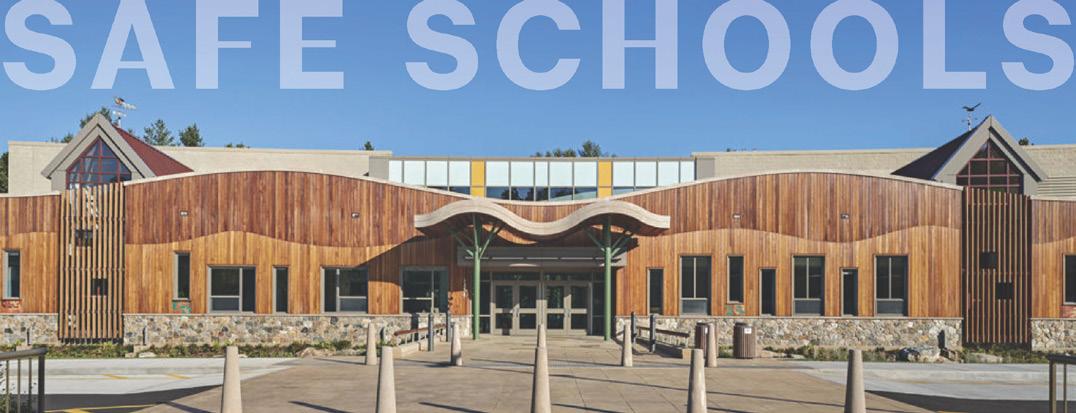
4 minute read
Legislative Achievements
Safe Schools by Design Act
On October 19, 2018, the AIA Committee on Architecture for Education convened a summit of architects, policymakers, students, educators, school administrators, law enforcement, building code officials, and mental health experts to examine violence in schools and explore ways to improve school safety and security through design of the built environment. This summit led to several recommendations, one being the creation of a central repository of resources and best practices for schools nationwide. As a direct result of AIA advocacy, this repository was included in the federal Bi-Partisan Safer Communities Act; specifically contained in the Luke and Alex School Safety Act.
Signed into law in June of 2022, the Safe Communities Act directs the Department of Homeland Security to maintain a repository of resources to help make schools safer and directs the U.S Department of Education to alert school districts to these resources.
Professional Certification Bill Defeated
To aid AIA efforts at the federal level, AIANYS drafted an in-house piece of legislation, the Safe Schools by Design Act (A.286-A Paulin/S.2629-A May), to ensure schools make a good faith effort to incorporate these best practices as part of their five-year capital planning process. Further, the bill expands the categories of funding for the New York State School Violence Safety Grant to include funding for programs which facilitate and promote community involvement in school facility planning, such as design charrettes and the community-focused design approach used in the process to design the new Sandy Hook Elementary School in Newtown, CT.

After three years of advocacy, and the determination of the sponsors Assemblymember Amy Paulin (AD 88-Westchester) and Senator Rachel May (SD 48-Syracuse), the Safe Schools by Design Act unanimously passed both houses of the NYS Legislature. The Safe Schools by Design Act will be transmitted to the governor for final action in the coming months. Once delivered, we will call on members to write letters in support of the bill to help ensure it’s signed into law.
The passage of the Safe School by Design Act underscores the importance of collaborative advocacy at the federal, state, and local levels. Together, we may continue to uphold and advance the universal and inescapable importance of design as a solution to some of society’s most pressing problems.
proponents framed the bill as a means to address building permit backlogs.
For the past few years AIANYS has grappled with a poorly drafted bill (A.4202-A /S.5614-A) aimed at expanding the use of professional certification programs in New York state. Initially proposed as a statewide bill, the scope was whittled down to local governments on Long Island and the City of Yonkers. Comprised predominantly of prodevelopment and business groups from Long Island, the
While AIANYS supports polices to eliminate unnecessary time delays in the permitting process, the bill in question is overly broad, ill-defined, and deficient in key areas to the point its passage would most likely harm the public, owners, and licensed architects and engineers. AIANYS spent months working with members on amendments to help provide a sensible way forward. When it became apparent that the legislative sponsors did not intend to wait for amendments and commentary, AIANYS issued a memo of opposition to the bill. The decision to oppose the bill after the expenditure of energy to provide alternative solutions was not made lightly, as a special Board of Directors meeting was called to address the matter and adopt the position. Ultimately, the bill ended up being held in both houses and did not advance this year.
AIANYS will take the off-session to continue a dialogue with the bill sponsors and work with the proponents of the bill to address lingering concerns.
Climate Action
All-Electric Buildings Act

The blockbuster policy proposal of the year was the passage of a scaled-down version of the All-Electric Buildings Act as part of the final State budget. The passage of this law makes New York the first state in the nation to mandate electrification in new buildings. Pursuant to the bill, beginning December 31, 2025, all new buildings under seven floors will be required to be all-electric (except new commercial or industrial buildings over 100,000 sq. ft.), and after December 31, 2028, all buildings will be required to be all-electric. This new law will not affect existing buildings, therefore, any buildings currently using fossil fuel infrastructure or equipment will not be required to transition to all-electric when their fossil fuel infrastructure or equipment has reached its useful life.
The law contains several other exemptions and exclusions including manufacturing facilities, commercial food establishments, laboratories, car washes, hospitals or other medical facilities, critical infrastructure, agricultural buildings, fuel cell systems, and crematoriums. Moving forward, the State Fire Prevention and Building Codes Council will have the authority to grant, extend, or modify exemptions to the law.
In its budget letter to the State Legislature, AIANYS expressed support for building electrification as a means to reduce operational carbon emissions, with recommendations to allow fossil-fuel equipment for back-up and standby power and an exemption if new
Climate Regulations
The Climate Leadership and Community Protection Act of 2019 (CLCPA) directs the NYS Department of Environmental Conservation (DEC) to promulgate rules and regulations four years after the enactment of the Act.

Therefore, the second half of 2023 will be crucial to the future of climate policy in the state as these draft regulations will be released for public review and comment.
These regulations will include legally enforceable emission limits, performance standards, and touch every sector of the economy.
or expanded electric service could not be provided by the public utility. Both recommendations were included in the final version of the law and should help enhance resiliency and flexibility to achieve compliance.
Regardless of these exemptions, buildings in the exempt class will still be required to minimize emissions and limit fossil fuel use to portions of a building where electrification is infeasible. Those portions of a new building authorized to use fossil fuel must be electric-ready, unless the building is used for agricultural, manufacturing, or industrial processes. AIANYS will continue to monitor and provide updates on the implementation of this new law and is looking to collaborate with NYSERDA on an educational webinar for members this Fall.
AIANYS engagement in this regulatory process will be crucial to ensure the voice of the architectural community is heard.
Beyond the drafting of regulations by the DEC, the State Fire Prevention and Building Codes Council will be faced with the monumental task of developing and adopting codes to comply with the decarbonization goals set forth in the CLCPA, the Advanced Building Codes and Appliance Equipment Standards of 2022, enhanced standards for buildings in a FEMA floodplain, and the rulemaking process required as part of the All-Electric Buildings Act. These statutory changes direct the Code Council to draft regulations related to high-performance envelopes, on-site energy storage and generation, electric-readiness, grid interactivity with electric appliances, the elimination of barriers to the residential adoption and use of ground-source heat pumps, and the prohibition of fossilfuel equipment in most new buildings.
For more information on the code development process and to participate in the conversation, please visit the State Fire Prevention and Building Code website at: https://dos.ny.gov/state-fireprevention-and-building-code-council




